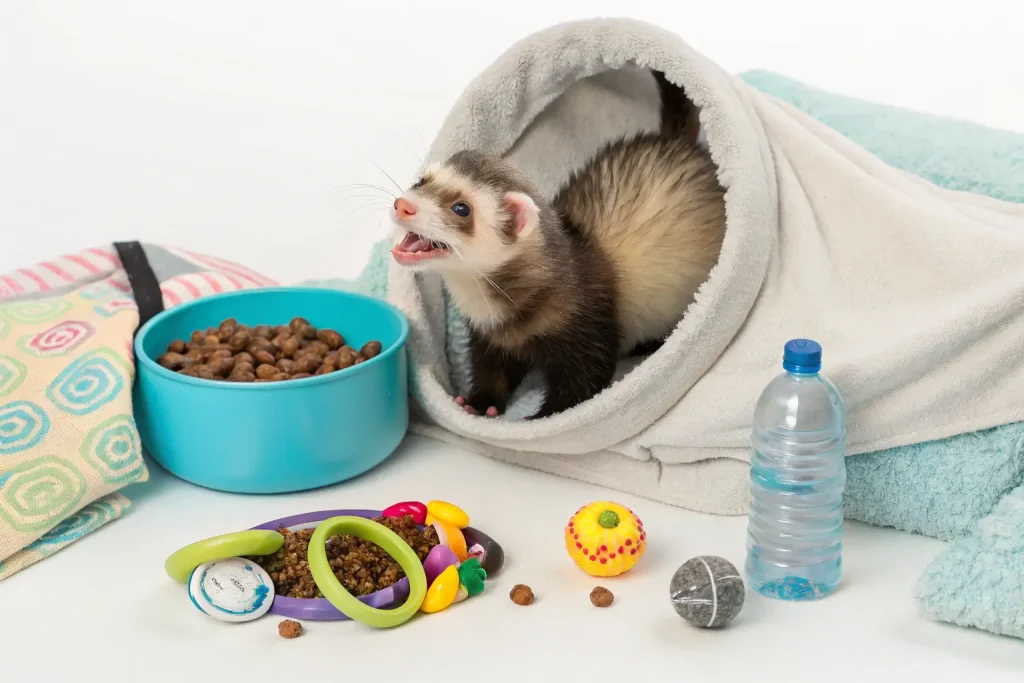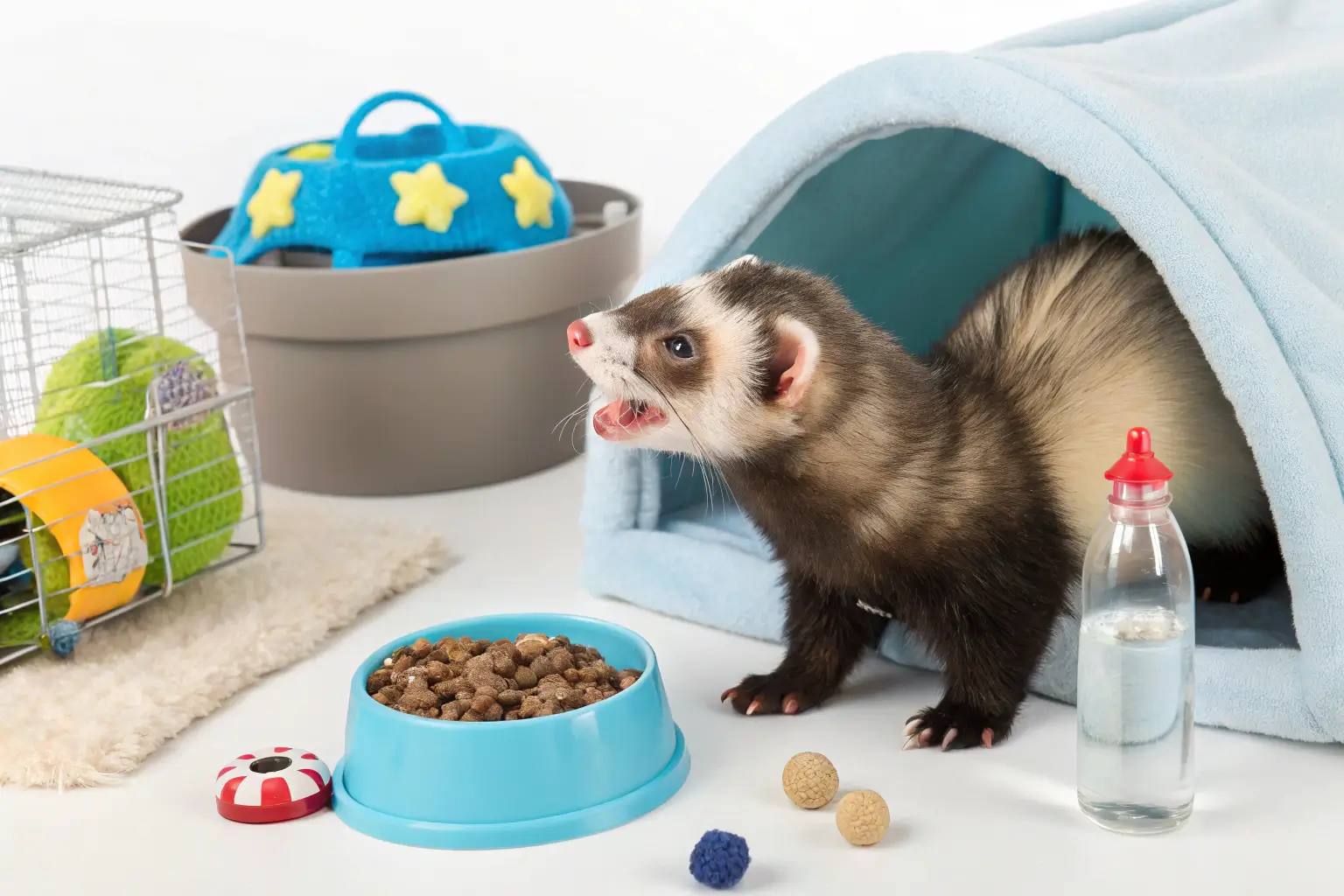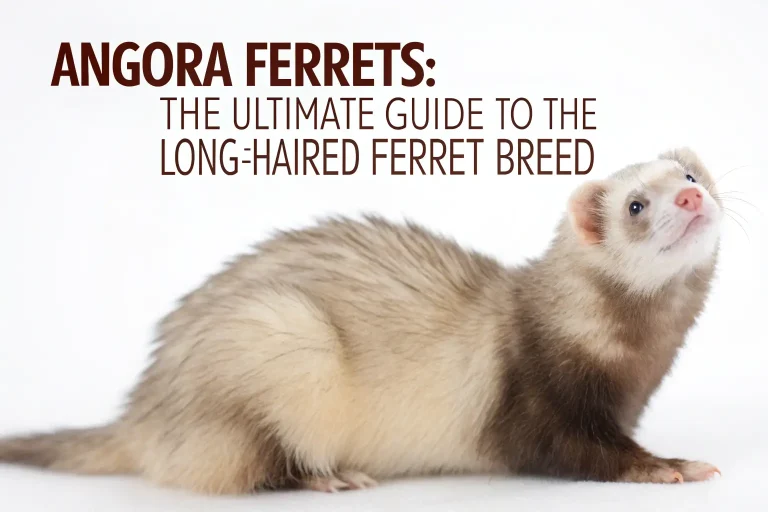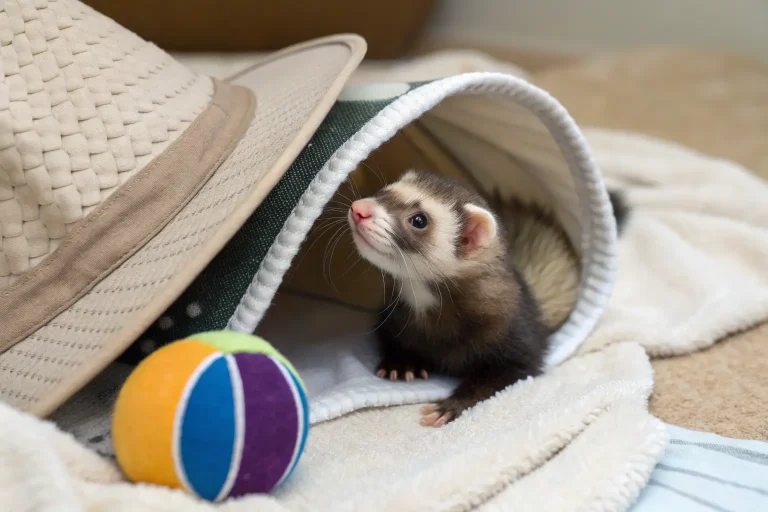Cute Ferret Essentials: 7 Tips for Happy, Healthy Pets
Got a cute ferret? Ensure your furry friend’s wellbeing with our top 7 essential tips for a happy, healthy pet. Discover easy solutions today!
Introduction
With their playful antics and boundless energy, ferrets have captured the hearts of pet enthusiasts worldwide. These adorable, mustelid mammals—known for their elongated bodies, curious personalities, and mischievous behavior—make captivating companions for those willing to meet their unique care requirements. Your cute ferret deserves proper attention and care to thrive in a domestic environment.
Understanding how to properly care for these enchanting creatures isn’t just important—it’s essential for their wellbeing. Ferrets have specialized needs quite different from cats or dogs, and providing proper care ensures they live their fullest, healthiest lives (which can span 6-10 years when well-maintained).
Did you know that ferrets sleep for 14-18 hours daily? Despite this impressive sleep schedule, when awake, they’re among the most energetic and curious pets you can own—a fascinating contradiction that makes ferret ownership both rewarding and entertaining. Their boundless enthusiasm when awake has earned them the nickname “carpet sharks” among devoted owners!
Species Overview
Scientific Name: Mustela putorius furo
Physical Characteristics: Domestic ferrets typically measure 13-16 inches in length (excluding their 4-6 inch tails) and weigh between 1-4 pounds, with males (hobs) generally larger than females (jills). These cute ferrets display various coat colors and patterns including sable (most common), albino, cinnamon, champagne, silver, and patterned variations like mitt or panda. They feature distinctive characteristics including elongated, flexible bodies, short legs, rounded ears, and bright, inquisitive eyes that reflect their intelligent nature.
Subspecies: While technically not a species but rather a domesticated form of the European polecat (Mustela putorius), domestic ferrets have been selectively bred for approximately 2,500 years. Unlike their wild cousins, domesticated ferrets depend entirely on human care and aren’t equipped for survival in natural environments. The black-footed ferret (Mustela nigripes), though similar in appearance, represents an entirely different species native to North America and remains one of the most endangered mammals on the continent.
Habitat and Distribution
Natural Habitat: Wild polecats (ferret ancestors) inhabit woodland edges, grasslands, and farmlands across Europe and parts of Asia. Domestic ferrets, however, have no natural habitat, having been bred exclusively for human companionship and historically for hunting purposes, particularly to chase rabbits and rats from burrows.
Geographic Range: As domesticated animals, cute ferrets can be found worldwide as pets, though their legal status varies significantly between countries and even between regions within countries. They’re particularly popular in North America, Europe, Japan, and Australia (though they’re banned in some Australian states and in California and Hawaii).
Adaptations: Ferrets have evolved numerous adaptations from their polecat ancestors, including slim, flexible bodies perfect for navigating narrow tunnels and burrows. Their sharp claws aid in digging, while their quick reflexes and keen sense of smell make them efficient hunters. Domesticated ferrets retain these physical adaptations but have undergone behavioral changes, becoming more sociable with humans and displaying longer periods of playfulness into adulthood compared to their wild counterparts.
Diet and Feeding Habits
What It Eats: Ferrets are obligate carnivores with extremely short digestive tracts designed specifically for meat consumption. Their natural diet consists primarily of whole prey items. In captivity, they require high-protein, high-fat diets with minimal carbohydrates and fiber. Commercial ferret-specific foods provide the balanced nutrition these pets need, containing 30-40% protein and 15-20% fat.
Hunting or Foraging Behavior: Though domesticated, ferrets retain strong hunting instincts. In natural settings, they employ their slender bodies to pursue prey through tight spaces, relying on scent rather than sight for hunting. Pet ferrets often display these behaviors through play, “stashing” toys and other items throughout the home—an amusing remnant of their ancestral food-caching behavior.
Dietary Needs: Your cute ferret requires consistent access to high-quality ferret food or kitten food that’s high in animal protein. Treats should be limited to small pieces of cooked meat or commercial ferret treats. Foods to avoid include fruits, vegetables, dairy products, and anything containing sugar or carbohydrates, which ferrets cannot properly digest and may cause severe digestive problems or even insulinoma (pancreatic cancer) over time.
Behavior and Social Structure
Social Behavior: Contrary to some misconceptions, ferrets are highly social animals that thrive with companionship. In domestic settings, they typically do best in pairs or small groups called “businesses.” Solitary ferrets require significantly more human interaction to remain mentally healthy. Cute ferrets establish dominance hierarchies when housed together, often sorted through play-fighting that rarely results in serious injury.
Communication: Ferrets communicate through a fascinating array of vocalizations and body language. Happy ferrets perform the characteristic “dook-dook” chattering during excited play, while hissing indicates fear or aggression. The infamous “war dance”—bouncing sideways with an arched back and puffed tail—signals extreme excitement or playfulness. Ferrets also communicate through scent marking, which diminishes but doesn’t entirely disappear with descenting surgery.
Mating and Reproduction: Female ferrets are induced ovulators, meaning they remain in heat until bred or given hormonal treatment. Unspayed females can develop potentially fatal aplastic anemia if left in prolonged heat. Pregnancy lasts approximately 42 days, with litters typically containing 4-8 kits. Babies are born blind, deaf, and nearly hairless, developing rapidly during their first weeks of life. For pet ferrets, spaying/neutering is strongly recommended not only to prevent unwanted litters but also to reduce musky odor and decrease aggressive tendencies.
Conservation Status
Endangerment Level: Domestic ferrets aren’t endangered or threatened, being fully domesticated animals. However, their wild cousin, the black-footed ferret (native to North America), was once considered extinct in the wild and remains listed as endangered by the IUCN Red List, despite successful reintroduction efforts.
Threats: While domestic ferrets face no extinction threat, they encounter various health challenges including adrenal disease, insulinoma, and lymphoma—conditions possibly linked to early spaying/neutering, genetic factors, and diet. Public misunderstanding about these pets has also led to banning in several regions, limiting where ferret enthusiasts can legally keep their pets.
Conservation Efforts: The most significant conservation efforts regarding ferrets focus on the endangered black-footed ferret, with captive breeding programs successfully reintroducing these animals to portions of their historic range. For domestic ferrets, advocacy groups work to improve public understanding of these animals as pets and lobby against restrictive legislation prohibiting ferret ownership.
7 Essential Tips for Happy, Healthy Ferrets

1. Create an Enriching Environment
Your cute ferret needs a spacious, multi-level cage (minimum dimensions of 24″ x 24″ x 18″) with ramps, hammocks, tunnels, and sleeping areas. Ferrets require at least 4 hours of supervised playtime outside their cage daily in a ferret-proofed space. Remove small objects that could be swallowed, secure reclining furniture, block escape routes, and eliminate access to foam, rubber, or latex items which ferrets may consume with potentially fatal consequences.
“My ferrets have transformed unused PVC pipes into their favorite playground,” shares Melissa, a ferret owner from Portland. “It’s inexpensive enrichment that keeps them mentally stimulated for hours.”
2. Maintain Proper Nutrition
Feed your ferret high-quality, meat-based commercial ferret food containing at least 30-40% protein and 15-20% fat. Establish regular feeding times, typically 2-3 meals daily, while ensuring fresh water is always available. Avoid foods containing sugars, fruits, vegetables, or excessive carbohydrates which ferrets cannot properly digest.
According to a 2020 study in the Journal of Exotic Pet Medicine, ferrets fed appropriate diets show significantly lower rates of insulinoma and digestive issues compared to those given improper nutrition.
3. Establish a Healthcare Routine
Schedule annual veterinary checkups with an exotic pet specialist familiar with ferret health. Monitor weight regularly as sudden losses or gains can indicate health problems. Stay current with vaccinations, specifically against rabies and canine distemper. Consider microchipping as ferrets are notorious escape artists. Watch for common health issues including adrenal disease, insulinoma, and lymphoma.
Dr. Karen Smith, exotic pet veterinarian, recommends, “Monthly at-home health assessments checking your ferret’s eyes, ears, teeth, and coat condition can catch problems before they become serious.”
4. Implement Proper Hygiene Practices
Bathe your cute ferret only when necessary (every 1-2 months) as frequent bathing increases oil production and odor. Trim nails every 2-3 weeks to prevent overgrowth and splintering. Clean ears gently with a veterinary-approved cleaner to prevent wax buildup and infection. Brush teeth weekly with ferret-safe toothpaste to prevent dental disease. Wash bedding weekly and clean the cage thoroughly every 1-2 weeks.
5. Socialize and Train Your Ferret
Begin handling your ferret gently from a young age to develop trust and comfort with human interaction. Spend dedicated time daily engaging in interactive play using appropriate toys. Train basic commands and behaviors including litter box usage (ferrets typically prefer corners). Use positive reinforcement with appropriate treats, never punishment. Introduce new experiences, people, and environments gradually to build confidence.
“Consistency is key with ferrets,” explains animal behaviorist Dr. Rebecca Johnson. “They learn through repetition and positive associations, not discipline.”
6. Provide Mental Stimulation
Rotate toys regularly to maintain interest and prevent boredom. Create engaging play scenarios like dig boxes filled with rice or ping pong balls in a shallow container. Introduce puzzle feeders that challenge your ferret’s problem-solving abilities. Set up supervised exploration time in new, safe environments. Consider training your cute ferret to perform simple tricks like rolling over or coming when called.
7. Ensure Proper Temperature Control
Maintain ambient temperatures between 65-75°F (18-24°C) as ferrets are susceptible to heat stress above 80°F (27°C). Provide cooling options during warmer months including ceramic tiles, cooling mats, or partially frozen water bottles wrapped in cloth. Ensure adequate warmth during colder months with proper bedding and sleeping sacks. Keep cages away from direct sunlight, heating vents, air conditioners, and drafts.
Data from a University of Minnesota study indicates that ferrets kept in properly controlled temperatures experience fewer respiratory issues and maintain healthier weights compared to those in fluctuating environments.
Interesting Facts
Ferrets possess incredibly flexible skeletal structures allowing them to squeeze through openings as small as 1 inch in diameter—making thorough ferret-proofing essential for owners.
A group of ferrets is whimsically called a “business,” likely referencing their industrious nature and constant busyness when awake.
Despite popular misconceptions, a properly cared for ferret’s natural musky odor is mild and manageable with appropriate husbandry practices.
Ferrets have historically served important roles beyond companionship, including laying telegraph and telephone cables by navigating small tunnels, delivering wires through confined spaces in aircraft construction during World War II, and traditionally hunting rabbits and rodents alongside human partners.
Their remarkable metabolisms require ferrets to eat approximately every 4 hours when awake—their bodies process food so efficiently they can’t store nutrients long-term.
The “ferret-legging” competition—where participants placed live ferrets inside their trousers with tightly fastened belts and cuffs—was once an actual endurance test in Yorkshire, England, with the world record exceeding 5 hours (a practice thankfully abandoned for animal welfare concerns).
Role in the Ecosystem
Ecological Importance: As fully domesticated animals, cute ferrets play no natural ecological role. Their wild ancestors, European polecats, serve as mesopredators controlling rodent populations and contributing to ecosystem balance. Similarly, endangered black-footed ferrets critically regulate prairie dog colonies in North American grassland ecosystems.
Impact of Decline: While domestic ferret populations remain stable under human care, the decline of wild mustelid relatives creates ecological imbalances. When black-footed ferrets nearly disappeared from North American prairies, prairie dog populations expanded unchecked, affecting grassland composition and other wildlife that depended on the ecosystem’s natural balance.
Conclusion
Providing optimal care for your cute ferret requires understanding their specific needs as domesticated carnivores with playful, intelligent personalities. From creating safe, enriching environments to establishing proper nutrition, healthcare routines, and social interaction, these unique pets thrive when owners recognize and accommodate their natural behaviors.
Remember that ferret ownership represents a significant commitment—potentially 6-10 years—requiring consistent care, appropriate veterinary attention, and dedication to their specialized needs. The rewards, however, prove immeasurable in the form of entertaining antics, affectionate bonds, and the unique joy that comes from sharing your life with these charming, mischievous companions.
Consider supporting ferret rescue organizations if you’re interested in adding these delightful pets to your family, as many ferrets need loving homes after initial owners underestimated their care requirements. By making informed, responsible choices regarding ferret ownership, you contribute to improving the welfare of these remarkable animals for generations to come.
Frequently Asked Questions
How long do ferrets typically live as pets?
With proper care, ferrets generally live 6-8 years, though some may reach 10 years of age. Their lifespan depends significantly on genetics, diet quality, preventative healthcare, and overall living conditions.
Do ferrets really smell bad?
Ferrets have a natural musky odor from glands in their skin, but it’s generally mild in spayed/neutered animals with proper hygiene. Most perceived “ferret smell” comes from unclean cages or bedding rather than the animals themselves. Regular cage cleaning, limited bathing (excessive bathing worsens odor), and washing bedding weekly significantly reduces any unpleasant smells.
Are ferrets good pets for children?
Ferrets aren’t typically recommended for households with children under 6 years old. Their quick movements and potential to nip when startled or handled roughly make them better suited for older children who understand proper handling techniques. Always supervise interactions between ferrets and children of any age.
How much does it cost to own a cute ferret?
Initial costs include $50-200 for the ferret (less from rescues, more from breeders), $100-300 for a quality cage, and $100-150 for supplies. Ongoing monthly expenses average $50-100 including food, bedding, and toys. Veterinary care costs $100-300 annually for routine visits, with emergency care potentially adding significant expenses. Budget for specialized exotic pet veterinary care throughout your ferret’s life.
Can ferrets be litter trained?
Yes, most ferrets can be litter trained, though rarely with 100% reliability. They naturally prefer using corners for elimination. Place litter boxes in cage corners and in play area corners for best results. Use ferret-specific litter or recycled paper pellets, avoiding clay, clumping, or cedar/pine products which can cause respiratory issues.
Do ferrets get along with other pets?
Ferrets may coexist with some cats and ferret-experienced dogs, but interactions should always be carefully supervised. Never house ferrets with prey animals (birds, rabbits, rodents) as ferrets retain strong predatory instincts. Introductions to other household pets should be gradual, controlled, and monitored for everyone’s safety.
Is it better to have one ferret or multiple ferrets?
Most ferret experts recommend keeping at least two ferrets together, as they’re highly social animals that benefit from constant companionship. Single ferrets require significantly more human interaction to prevent depression and behavioral problems. When introducing new ferrets, do so gradually in neutral territory to establish positive relationships.







